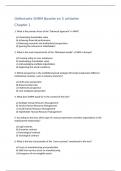Tentamen (uitwerkingen)
190 Oefenvragen Strategic Human Resource Management met artikelen
- Instelling
- Radboud Universiteit Nijmegen (RU)
Oefen voor je SHRM tentamen met deze 190 oefenvragen. Gebaseerd op de echte toets! Alles word behandeld in deze vragen
[Meer zien]














